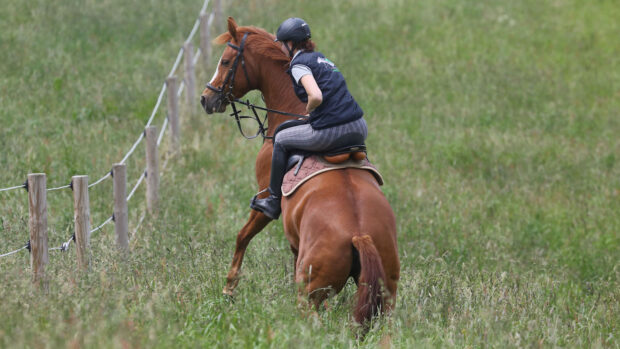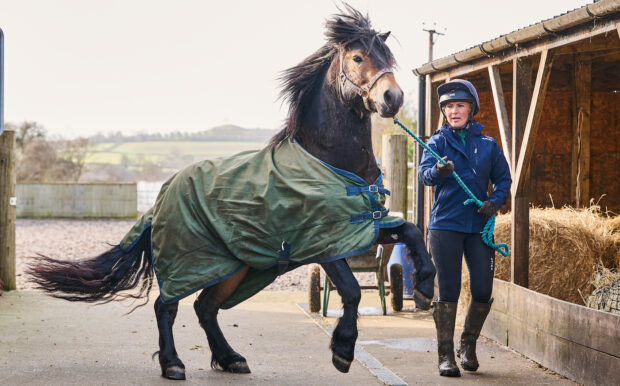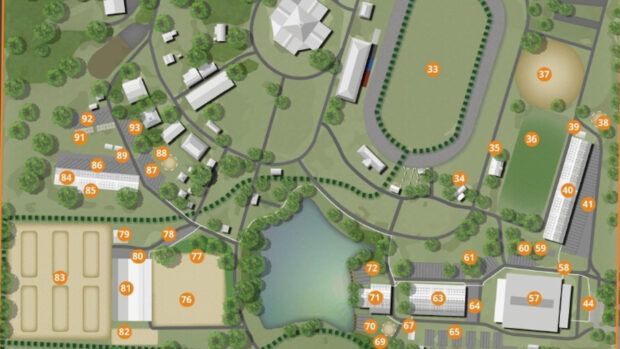To be an effective horse trainer and rider, we must endeavour to understand how horses learn, and to work within that framework. In the first part of this series on the theory of horses’ learning processes, we examined the first level – non-associative learning. After this comes classical conditioning and operant conditioning. In this article, we will look at classical conditioning for horses, the second level of learning.
What is classical conditioning for horses?
Most people are familiar with the story of Pavlov’s dogs. Pavlov was a Russian scientist who rang a bell and then fed the dogs in his experiment. It did not take long before the dogs would start to salivate and wag their tails when they heard the bell, even though no food was present.

Pavlov’s dogs: predicting what comes next due to a stimulus. The dogs learned to associate the bell with imminent provision of food. Credit: Alamy
Classical conditioning is all about predicting what will happen next because the order of events is always the same. Classical conditioning results in an emotional state being triggered by a previously neutral stimulus – once trained, Pavlov’s dogs became excited when they heard the bell because it predicted food.
Another key aspect to understand is that the neutral stimulus (in that case, the bell) has to be presented before the innate reinforcer (the food). If the bell was rung after the food, or even at the same time as food was presented, the effect would not be the same.
We can use classical conditioning as part of good training, but we should also be aware of where it causes us problems.
How can we use it?
One way is always to give a postural cue immediately before an aid from the leg or hand, such as slowing your rising in trot before asking for a downwards transition. You will be surprised how quickly your horse learns to respond to the postural cue alone – getting you top marks for harmony.
We can also use this phenomenon to introduce horses to novel stimuli. If you have a young horse you can stand them near to other horses who are being shod and associate this with something nice like a mineral lick or getting stuck into their favourite scratchy spots.

Giving your horse something nice to lick, or a good scratch, can build positive associations with something new or that they may find scary. Credit: Andrew Sydenham
You have to stand far enough away that they can remain calm and enjoy the experience, but if you always present something nice when farriers start working then the arrival of a farrier will have the same effect as Pavlov’s bell – and you will have a happy, relaxed horse who will less likely to be concerned about their first set of shoes.
When does it cause us problems?
Perhaps you have a horse who lacks confidence to jump a filler. If the horse is put under pressure every time they approach a filler (by leg, voice or whip) they will start to associate the sight of a filler with increased pressure from the rider.
As a human we have the cognitive capacity to understand that if they jump it they won’t be put under pressure. But horses can’t rationalise thoughts like these. So instead, they see the filler, which triggers negative emotions like fear and anxiety and so they, understandably, want to avoid it.

A horse may associate the sight of a spooky jump with an increase in pressure from the rider, but with time and patience, you can build their confidence so they no longer anticipate the perceived threat. Credit: Alamy
Instead, it is better to help the horse form positive associations with fillers so they become more confident. This might start with walking towards one, stopping before they get too close and become fearful, letting them stand and then giving them a scratch, then repeating this several times. Now approaching the filler predicts a reduction in pressure and the possibility for a positive experience (the scratch).
Once they are confident try walking then trotting between two fillers with a wide gap that you gradually make smaller – remember to keep it easy, the aim is that the sight of the filler elicits positive emotions and not negative ones.
You could even jump over several other fences before trotting between the fillers and then bring the horse back to walk on a long rein for a minute on the other side. Approaching the filler now predicts a break in training and the horse will be actively wanting to take you to it. At this point the gap is probably that small that they are jumping the filler.
To counteract the risk that the horse will learn to stop after a filler, once you have them confident to jump it and they are drawing you to it, pop the filler and then ask for a circle in canter before coming back to walk. Build up to where they jump it and look for the next question.
If you have trained this well it will become their favourite jump!
Case study for classical conditioning: overcoming clipper fear
A teenage cob mare was the perfect horse for her owner, apart from her aversion to clippers. Even when sedated she became dangerous to clip. In this scenario the clippers elicited a fear response that overrode the sedation.
We started by turning on some human beard clippers, giving her a handful of chaff and turning them off again. The noise was below the threshold that elicited a fear response and the sound soon began to predict food. Gradually the beard clippers were brought closer and then rubbed on her body, turning them on was still always followed by food.
The same process was repeated with small and eventually large clippers. Anyone watching would have found the process boring as she remained calm throughout – a sign of good training. Now she stands with no sedation to be clipped all over.

An aversion to clipping can be worked through slowly and patiently, using classical conditioning to teach the horse that the noise of the clippers indicates an imminent reward. Credit: Getty/Kit Houghton
We’ve now covered non-associative learning and classical conditioning as two important levels in the theory of how horses learn. The next and final part of this series will address operant conditioning – or, in layman’s term, rewards and consequences.
You may also enjoy reading…

Why is my horse over-reacting? Become a better trainer by understanding how horses learn

*Exclusive*: ‘Not every day is a perfect day – patience and positivity are very important’: Lottie Fry shares her training mantras

‘The more we reward, the more we’re going to get back’: Cathrine Laudrup-Dufour’s top training tips

*Exclusive* Boost your confidence in the saddle with these 6 steps to channel focus and shake off the nerves

*Exclusive* Build your confidence in handling horses on the ground, whether you’re a rider or the vital helping hand




